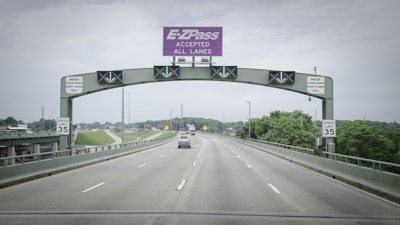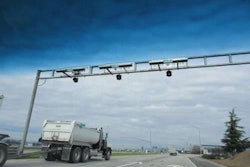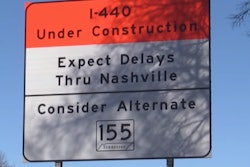 A reluctance among Washington lawmakers to institute new taxes make the prospects for a Highway Trust Fund fix appear bleak, casting increasing uncertainty about its future and its ability to pay for upkeep and expansions. This has left more states in pursuit of their own revenue sources, which include ramped-up tolling efforts.
A reluctance among Washington lawmakers to institute new taxes make the prospects for a Highway Trust Fund fix appear bleak, casting increasing uncertainty about its future and its ability to pay for upkeep and expansions. This has left more states in pursuit of their own revenue sources, which include ramped-up tolling efforts.Uncertainty about shoring up the bankrupt U.S. Highway Trust Fund to address the nation’s crumbling transportation infrastructure has led some states to find new revenue sources, including tolls that target trucks.
“Our predictions are coming true,” says Darrin Roth, vice president of highway policy for the American Trucking Associations. “Even though about half of states have increased their own fuel taxes or registration fees, all they’ve done is made up somewhat for lost time. Many of them haven’t increased those fees for decades, so they’re just catching up.”
Since 2008, the Highway Trust Fund has needed more than $140 billion in IOUs from the U.S. Treasury to stave off insolvency. The fund’s revenue source – per-gallon taxes on gasoline and diesel, which haven’t been increased since 1993 – has since been crippled by inflation and improvements in fuel-efficiency.
Congress has let the issue flounder despite urgent cries from the business community and the public at large. It’s also despite lawmakers and Presidents Trump and Obama crowing annually about the dire status of America’s infrastructure and their intentions to address it.
At least four states in the past 12 months have enacted or considered truck-specific toll plans. These proposals follow years of warnings from highway funding advocacy groups and trucking groups about highway funding “devolution” — that is, highway funding rolling downhill to states and the likely expansion of tolled highway lanes that would come with it.

Until recently, says Roth, truck tolling proposals popped up every two to three years. “Now we’re seeing something up every two to three months,” he says. “I expect that trend to continue and to accelerate.”
Likewise, the Owner-Operator Independent Drivers Association points to federal inaction as a key cause of the recent truck tolling plans. President Todd Spencer says there’s been “a clear and distinct turn away from traditional methods for funding highways, and that move was to the idea of basically selling off our roads to be converted to toll roads.”
ATA and OOIDA endorse fuel tax increases to support highway projects. They argue fuel taxes are more efficient in their collection and use of revenue and more equitable for users.
“Congress has continued to kick the can down the road on creating sustainable road funding, and the result is states are getting backed into a corner,” says Stephanie Kane, spokesperson for the Alliance for Toll-Free Interstates. The coalition represents dozens of companies and organizations, including OOIDA and ATA.
Moving toward truck tolls is an “alarming trend,” says Kane. Trucking is “a very easy scapegoat, because politicians think they can blame out-of-state trucks and tax those out-of-state trucks via tolls.”
Kane also blames the trend partly on misinformation among lawmakers and the public. Truckers, she points out, pay higher fuel taxes as well as IFTA taxes, meaning they pay much more per mile for use of roadways than other motorists.
Politicians “want a free lunch on transportation funding,” Kane says. “But putting it on the back of the trucking industry is neither fair nor smart.”
However, those indifferent to or supportive of increased tolling efforts see it as a new normal that all parties must acknowledge.
“It’s one of the options,” says Pat Jones, head of the International Bridge, Tunnel and Turnpike Association. “It’s not the only one, but it’s a very powerful and effective one.” The American Association of State Highway and Transportation Officials also promotes tolling as one of many funding options for states, says Joung Lee, the group’s director of policy.
Jones argues that the $140 billion borrowed from the general fund in the past decade highlights the fuel tax’s shortcomings. “Any suggestion that users are paying to support the Highway Trust Fund is partially false,” he says.
He also takes ATA and OOIDA to task on their calls for fuel tax increases. “While they continue to push for a gas tax increase at the federal level, it’s doubtful that we’ll have one,” Jones says. “It’s nice to push for something that isn’t going to happen and say, ‘We’re in favor of paying more,’ but in reality they’re not paying more at the federal level. If you’re willing to pay more, I don’t understand why they wouldn’t agree tolling is one of the options to do that.”
Weighing fuel taxes and tolls
The American Trucking Associations and Owner-Operator Independent Drivers Association advocate for fuel tax increases as a potential fix for the Highway Trust Fund. Though OOIDA hasn’t specified a plan, ATA in recent years has pushed its Build America Fund, which calls for nickel-a-year increases in per-gallon taxes on diesel and gasoline for four years. That would add 20 cents a gallon to each, pushing them to 44.4 cents for diesel and 38.4 cents for gasoline.
“Tolls are a much less efficient way of collecting revenue,” says Darrin Roth, ATA’s head of highway policy. “With fuel taxes, about 1 percent or less of revenue goes toward collection costs. For tolls, even using the most advanced collection system, it’s somewhere around 10 to 12 percent.”
Tolls also push trucks and other traffic onto secondary roadways — “roads that are not as safe and not as well-built as an interstate,” he says.
OOIDA President Todd Spencer says fuel taxes are the fairest funding mechanism for truckers and motorists, as they’re based on fuel consumption and highway use.
Also, “fuel taxes, you can pass along [to customers] with fuel surcharges,” says Spencer. “Truckers will have a great deal of difficulty passing through increased costs for tolls to the people they ultimately have to collect money from.”
Spencer also argues that tolls are “bad public policy,” given that they’re often owned by private entities. “The priority is a return to investors,” he says.
Pat Jones, head of the International Bridge, Tunnel and Turnpike Association, which represents toll operators, disagrees. Jones suggests that fuel taxes alone no longer can sustain the country’s need for highway funding and that states and the federal government must develop new revenue sources, including tolls.
He points to a recent study by the Transportation Research Board – a wing of the independent nonprofit National Academies of Science – about the future of transportation funding. The TRB study concluded that fuel tax increases, whether at state or federal, could boost highway funding only for the short term because hybrid and electric vehicles are becoming more common. “Long term, diesel and gasoline are not going to be the primary propulsion method for our vehicles,” Jones says.
Funding mechanisms such as vehicle-miles-traveled taxes and other forms of distance charges will need to become more prevalent as alternative fuels replace conventional combustion engines, he says. Though some states have considered implementing such mileage-based taxes, Oregon is the only state to have enacted such a policy. In 2015, it began testing a VMT system that allows residents to elect to pay VMT instead of fuel taxes.
The TRB report also advocates for a repeal of the ban on adding tolls to existing interstate lanes to give states the flexibility to toll them. The idea has been floated repeatedly for years but has never come to pass.
States try an end-run on tolling
Though the federal government bans states from adding tolls to existing interstate lanes, some states are finding creative ways to convince the U.S. Department of Transportation to let them circumvent that ban. Rhode Island’s truck tolling plan was cleared by DOT’s Federal Highway Administration, and other states are watching lawsuits against it and could follow suit should the plan survive.
Rhode Island’s controversial trucks-only toll plan was enacted in 2016. To circumvent the federal ban on tolling interstate lanes, Rhode Island filed its plan under an exemption that lets states use tolls for bridge and tunnel projects.
“It’s meant to allow states to fund extremely expensive projects that just aren’t possible using their normal revenue streams,” says Darrin Roth, head of highway policy for the American Trucking Associations. “But Rhode Island has used it in a way that was never intended.”
ATA is suing the state over the RhodeWorks plan, which will charge truckers up to $40 a day to travel through the state.
Virginia and Connecticut have said they’ll likely decide whether to proceed with similar initiatives based on the outcome of ATA’s legal challenge against RhodeWorks.
The Owner-Operator Independent Drivers Association also is fighting truck tolls in court, having sued Indiana in January over the state’s recent price increase.
Though Indiana already tolled sections of I-80 and I-90 on its Indiana Toll Road, Gov. Eric Holcomb last October announced a 35 percent price hike for truckers traveling a 150-plus-mile section between the Ohio Turnpike and Chicago Skyway. Trucks traveling across the state now pay $60 a day, up from $44.
OOIDA is seeking a refund for tolls and a reversal of the policy.









